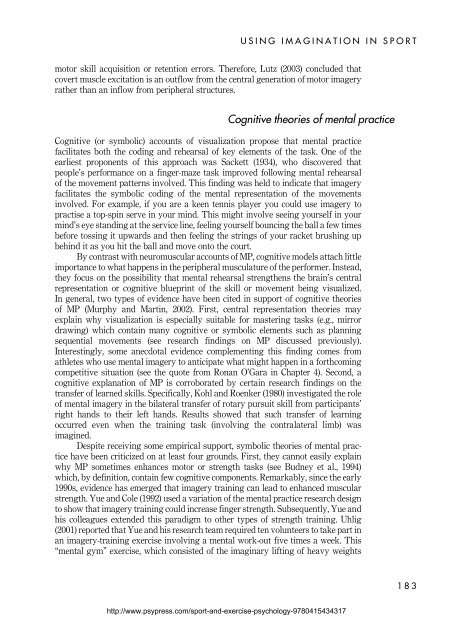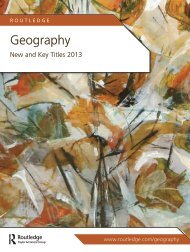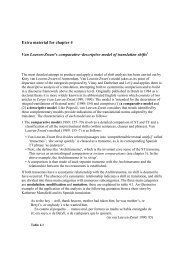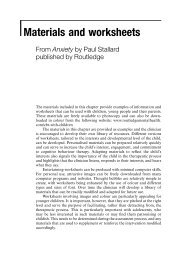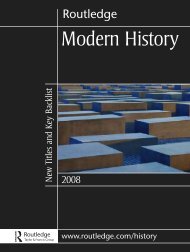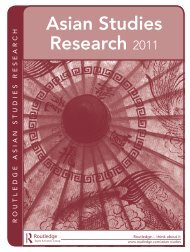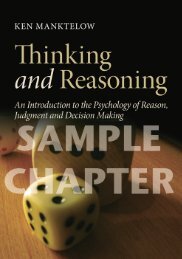Sport and Exercise Psychology: A Critical introduction ... - Routledge
Sport and Exercise Psychology: A Critical introduction ... - Routledge
Sport and Exercise Psychology: A Critical introduction ... - Routledge
Create successful ePaper yourself
Turn your PDF publications into a flip-book with our unique Google optimized e-Paper software.
USING IMAGINATION IN SPORT<br />
motor skill acquisition or retention errors. Therefore, Lutz (2003) concluded that<br />
covert muscle excitation is an outflow from the central generation of motor imagery<br />
rather than an inflow from peripheral structures.<br />
Cognitive theories of mental practice<br />
Cognitive (or symbolic) accounts of visualization propose that mental practice<br />
facilitates both the coding <strong>and</strong> rehearsal of key elements of the task. One of the<br />
earliest proponents of this approach was Sackett (1934), who discovered that<br />
people’s performance on a finger-maze task improved following mental rehearsal<br />
of the movement patterns involved. This finding was held to indicate that imagery<br />
facilitates the symbolic coding of the mental representation of the movements<br />
involved. For example, if you are a keen tennis player you could use imagery to<br />
practise a top-spin serve in your mind. This might involve seeing yourself in your<br />
mind’s eye st<strong>and</strong>ing at the service line, feeling yourself bouncing the ball a few times<br />
before tossing it upwards <strong>and</strong> then feeling the strings of your racket brushing up<br />
behind it as you hit the ball <strong>and</strong> move onto the court.<br />
By contrast with neuromuscular accounts of MP, cognitive models attach little<br />
importance to what happens in the peripheral musculature of the performer. Instead,<br />
they focus on the possibility that mental rehearsal strengthens the brain’s central<br />
representation or cognitive blueprint of the skill or movement being visualized.<br />
In general, two types of evidence have been cited in support of cognitive theories<br />
of MP (Murphy <strong>and</strong> Martin, 2002). First, central representation theories may<br />
explain why visualization is especially suitable for mastering tasks (e.g., mirror<br />
drawing) which contain many cognitive or symbolic elements such as planning<br />
sequential movements (see research findings on MP discussed previously).<br />
Interestingly, some anecdotal evidence complementing this finding comes from<br />
athletes who use mental imagery to anticipate what might happen in a forthcoming<br />
competitive situation (see the quote from Ronan O’Gara in Chapter 4). Second, a<br />
cognitive explanation of MP is corroborated by certain research findings on the<br />
transfer of learned skills. Specifically, Kohl <strong>and</strong> Roenker (1980) investigated the role<br />
of mental imagery in the bilateral transfer of rotary pursuit skill from participants’<br />
right h<strong>and</strong>s to their left h<strong>and</strong>s. Results showed that such transfer of learning<br />
occurred even when the training task (involving the contralateral limb) was<br />
imagined.<br />
Despite receiving some empirical support, symbolic theories of mental practice<br />
have been criticized on at least four grounds. First, they cannot easily explain<br />
why MP sometimes enhances motor or strength tasks (see Budney et al., 1994)<br />
which, by definition, contain few cognitive components. Remarkably, since the early<br />
1990s, evidence has emerged that imagery training can lead to enhanced muscular<br />
strength. Yue <strong>and</strong> Cole (1992) used a variation of the mental practice research design<br />
to show that imagery training could increase finger strength. Subsequently, Yue <strong>and</strong><br />
his colleagues extended this paradigm to other types of strength training. Uhlig<br />
(2001) reported that Yue <strong>and</strong> his research team required ten volunteers to take part in<br />
an imagery-training exercise involving a mental work-out five times a week. This<br />
“mental gym” exercise, which consisted of the imaginary lifting of heavy weights<br />
http://www.psypress.com/sport-<strong>and</strong>-exercise-psychology-9780415434317<br />
183


